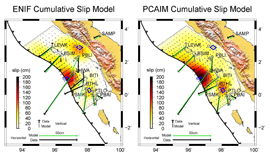Overview
PCAIM (Principal Component Analysis-based inversion Method) software can be used to recover the time-evolution history of the source of surface deformation (e.g., slip on a fault or magmatic inflation).
The software takes a time series of surface deformation data (such as GPS data) and from that data determines the time evolution of slip on the underlying fault. It can do this over a range of time variation, and thus can reveal both seismic and aseismic slip.
The software uses an inversion strategy that relies on principal component analysis of the surface displacement time-series.
|

Location of GPS stations that recorded postseismic deformation following the 2005,
Mw 8.6 Nias earthquake and comparison of cumulative slip distributions 334 days after the 2005
Nias earthquake obtained from the ENIF [Hsu et al., 2006] (left) and PCAIM (right) inversions.
|
|
This project has benefitted from useful discussions with Mohamed Chlieh, Tapio Schneider, Malcom Sambridge, and Nathan Srebro. The code has improved thanks to testing by Ya-Ju Hsu, Marion Thomas, and Nina Lin.
|
We acknowledge support by the Gordon and Betty Moore Foundation (through the Tectonics Observatory), the National Science Foundation (through grant EAR-0838495), the Institut de Recherche pour le Developpement, and the Caltech SURF program.
|
|

